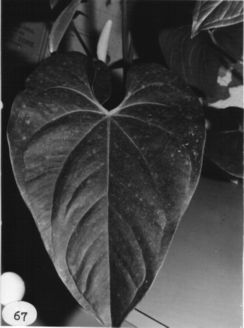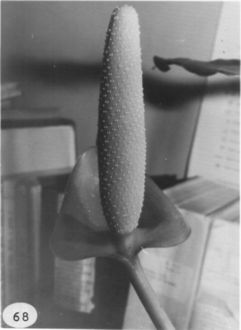





TYPE: Panama. Chiriquí: cloud forest along Continental Divide on Cerro Colorado on upper mining road, 20-28 mi. above San Felix, 1,200-1,500 m, Croat 33332 (MO, holotype; PMA, US, isotypes; Live at MO).
Epiphyte; stems more than 10 cm long, 3-4.5 cm diam.; leaf scars ca. 1.5 cm wide; roots ca. 5 mm diam. descending; cataphylls coriaceous, 9-16.5 cm long, apiculate at apex, drying dark brown (B & K Yellow 4/5), persisting intact.
LEAVES erect to spreading; petioles subterete, 20-54(-70) cm long; geniculum 3-4.2 cm long; blade ovate, coriaceous, long-acuminate at apex, deeply lobed at base, 19-45.5 cm long, 13-32 cm wide, broadest between point of petiole attachment and midway; anterior lobe 14-34 cm long, the margins rounded to convex; posterior lobes 4.5-16.2 cm from apex of sinus to outermost point; sinus hippocrepiform to parabolic, rounded at apex; upper surface matte to semiglossy, lower surface semiglossy; midrib convexly to acutely raised above, diminishing and sunken toward apex, convexly raised at base below, more acute toward apex; basal veins 4-6 pairs, first to second, sometimes third, free to base, those remaining coalesced 0.5-3.5 cm, raised above and below; posterior rib naked, turned up on outermost margin; primary lateral veins 3-5 per side, departing midrib at 30-50° angle, sunken above, prominulous below, lesser veins scarcely visible, drying raised on both surfaces; collective vein arising from the first basal vein or one of the primary lateral veins in the apical one-third of blade, sunken above, raised below, 3-7 mm from margin.
INFLORESCENCE erect, shorter than leaves; peduncle terete, 11-15 cm long, 5-7 mm diam., ca. one-third as long as petioles; spathe pale green (B & K Yellow-green 7/10), coriaceous, oblong-ovate to broadly ovate, 8-11.5 cm long, 3-5.5 cm wide, broadest near the base, caudate-acuminate at apex, obtuse, rounded to sub-cordate at base; spadix pale green to white, 6-9 cm long, 1-1.6 cm diam. midway, scarcely tapered at both ends; flowers 4-lobed, 2-3 mm long, 2.1-3.5 mm wide, sometimes equal in both directions, the sides jaggedly sigmoid, 12-22 flowers visible in the principal spiral, 7-15 visible in the alternate spiral; tepals matte to glossy, lateral tepals 1-1.6 mm wide, the inner margin broadly rounded; pistils scarcely emergent, white; stigmas linear, ca. 0.3 mm long; stamens emerging scattered throughout spadix, laterals first, exserted for some time before alternates emerge; anthers white, clustered around pistil, 0.4-0.6 mm long, 0.6-0.8 mm wide; thecae ovate-elliptic, slightly divaricate; pollen white.
INFRUCTESCENCE with spathe persisting; spadix to 15 cm long, ca. 3 cm diam.; berries yellow, rounded at apex, mesocarp gelatinous; seeds 2, 3-3.5 mm long, 2-2.5 mm wide, 1.1-1.2 mm thick, flattened, enveloped in a gelatinous substance. Figs. 67 and 68.
Anthurium fusiforme is endemic to Panama and is known only from the Fortuna and Cerro Colorado regions in premontane forest life zones at 1,000 to 1,400 m.
The species, a member of section Calomystrium, is distinguished by its persistent, thick, intact cataphylls, its thick ovate blades with the collective vein arising from the uppermost basal vein or one of the primary lateral veins, and especially by its pale green, fusiform spadix, which is unlike that of any other known species of Anthurium.
Vegetatively the species could be confused with Anthurium hoffmannii or A. formosum, but both of the latter have the collective vein usually close to the margin, whereas the collective vein of A. fusiforme is more distant from the margin.
 |
 |
Map of Mesoamerican specimens with coordinates
Panama Bocas del Toro: 600 m, 8.45N 82.18W, 25 June 1987, Thomas B.
Croat 66793 (MO).
Panama Chiriquí: 1200 m, 8.45N 82.18W, 23 June 1987, Thomas B. Croat
66715 (CM,MO,SCZ).